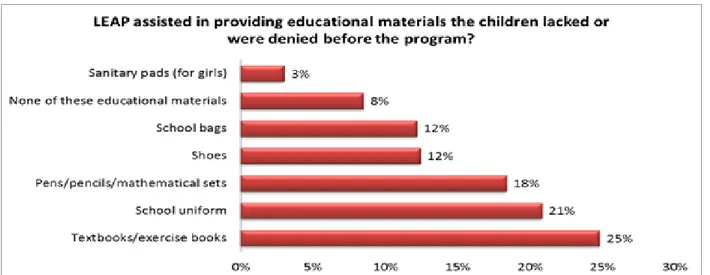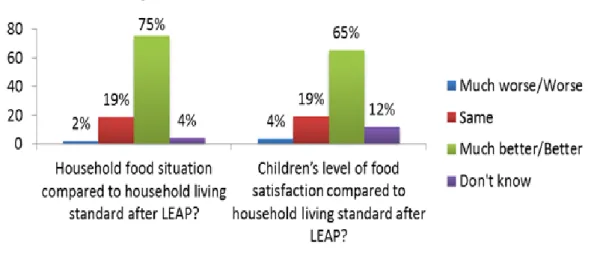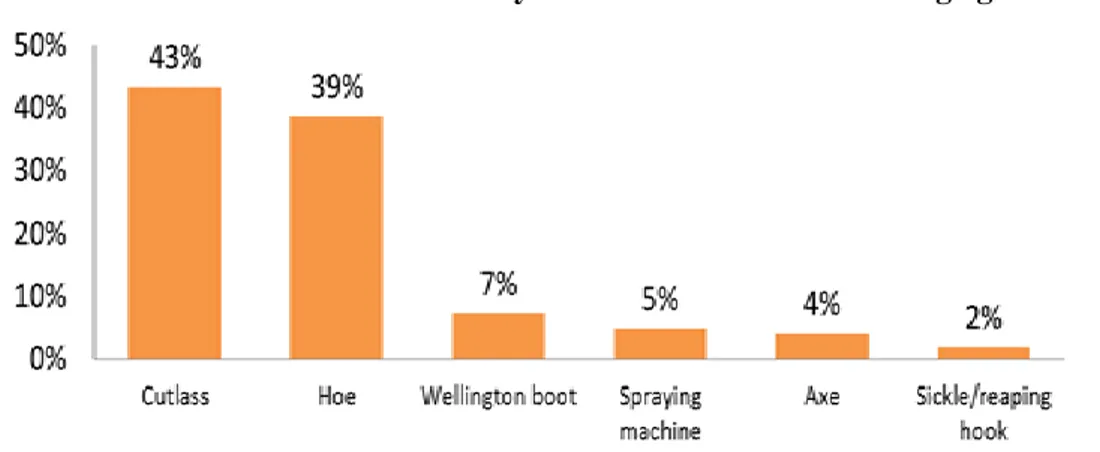P a g e 1
N
O
.35
ADVANCING OUT OF POVERTY IN GHANA: THE ROLE OF THE
L
IVELIHOOD
E
MPOWERMENT
A
GAINST
P
OVERTY
(L
EAP
)
P
ROGRAM
April 2017
Razak Oduro, Regina Oforiwa Amanfo
The Ghana Center for Democratic Development
In this policy brief, we present an analysis of a household survey conducted on the
utilization of the receipt of Livelihood Empowerment Against Poverty (LEAP) cash
transfers in Ghana. The focus of the study was to track and ascertain the contribution
of the LEAP program in reducing poverty and vulnerability in the lives of
beneficiaries.The study revealed that king a difference in the lives of the poor
beneficiaries in the short-term by improving school attendance of children,
incentivizing children to stay in school, households being covered by health insurance
and are able to purchase limited agricultural products.However, the findings suggest
that there is little or no guarantee for a sustained poverty alleviation in a much longer
term because the LEAP cash amounts were not enough to cater for the needs of all
household members. We recommend that LEAP takes a social investment approach in
the lives of the poor with aim to facilitate beneficiaries into a sustainable employment
and economic opportunities
.In recent years, social protection programs have emerged as a major policy framework designed to address poverty and vulnerability, particularly in developing countries. In respect of this, there has been a great deal of innovation around developing regular and reliable social assistance programs, such as cash transfers for vulnerable families to mitigate the dire consequences of poverty and to break inter-generational transmission of extreme poverty (Barrientos, 2011; Oduro, 2015). These cash transfers are aimed at strengthening human
P a g e 2
capital as well as providing incentives for the deprived to invest in their future in order to advance out of poverty. Cash transfers have therefore been featured high in social policies of national governments such as Brazil, Mexico, Kenya etc. and international development agencies, such as the World Bank. In 2008, Ghana, as part of its efforts to reduce abject poverty and vulnerability, launched a Livelihood Empowerment Against Poverty (LEAP) programme to provide cash support to extreme poor households to overcome barriers that constrain access to social services such as health and education. In this study, CDD-Ghana sought to assess the contribution of LEAP in the everyday lives of poor and vulnerable households in Ghana in relation to access to education, health services, household food security and asset accumulation.
Enhanced School Enrolment and Adult Education
The study found that LEAP contributed to 12% increase in school enrolment of children. Approximately eight out of ten school-going age children were enrolled in school as a result of the LEAP program. Beyond the norm of school enrolment, the study also found that LEAP assisted households to supply educational materials to children which served as incentives for school attendance. Figure 1 shows how the LEAP cash transfers were utilized in the provision of educational materials for children.
Figure 1: Provision of Educational Materials
The survey asked respondents to rate education status after the LEAP program in comparison with non-LEAP period. It was found that about 66% of the respondents claimed that the non-LEAP has made school attendance much better; 65% indicated LEAP has given children much better motivation to attend school; and about 65% of the respondents also believe that LEAP has reduced absenteeism in schools except when children are sick. Though, the study found LEAP contributed positively in children’s education, a number of respondents reported about school absenteeism among children. Reasons found included extra demands from teachers (50%), inability to supply all educational materials due to the number of children in the household (34%) and also children assisting in farm work during school days (5%)
Interestingly, the objective of the LEAP is to encourage school enrolment and attendance of school-going age children; however, the survey found that LEAP assisted some adults (13%) in beneficiary households to enroll into adult education programs.
P a g e 3
Enhanced Health Services
The study examined how the LEAP cash transfers assisted beneficiaries to enroll onto a health insurance scheme. It was found that 67% of beneficiaries were registered on the national health insurance scheme (NHIS).
Figure 2: LEAP and health insurance enrolment
Although six out of ten respondents were enrolled onto the NHIS, 20% of these respondents did not have valid insurance cards to access health care. Respondents were then asked why the registered member of the NHIS did not have valid cards and 59% indicated they had not renewed the NHIS registration because they were unable to pay for the insurance premiums. Also, the use of traditional and herbal medicines influenced the decision to enrol onto health insurance. In relation to how the LEAP transfers were utilized or how LEAP assisted beneficiaries to address other household health care needs, the study found that seven out of ten respondents (72%) indicated that the LEAP transfers assisted them to purchase drugs from medical shops and a relatively few of the respondents (6%) used the LEAP transfers to access traditional or herbal medicines. About 19% of the respondents also reported the LEAP cash transfers were used for transport to the health care centres in their districts.
Food Supply
The survey asked respondents how the LEAP cash transfers assisted them to supply food items for the household. It was found that LEAP was crucial in the provision of stable foods for beneficiary households. However, beneficiaries indicated that the LEAP cash amount was not adequate to provide a three square meal for the household children. Household size also accounted for reasons why children had to skip meals. Respondents were also asked to compare access to food and level of satisfaction before and after the receipt of LEAP cash transfers. It was found that household food situation had improved after the LEAP program albeit the increase in food prices.
P a g e 4
Seventy-five percent (75%) of respondents indicated that their household food situation is much better after the implementation of LEAP;19% of respondent indicated that household food situation is the same whereas a relatively low proportion of respondents indicated their living standards in relation to provision of food is worse. In relation to this, about 7 out of every 10 respondents believe LEAP has made their children’s level of food satisfaction much better. 19% of the respondents reported that children’s level of food satisfaction is still the same.
Asset Accumulation
The survey also examined how LEAP has contributed to asset accumulation and other investments as measures to advance out of poverty. The study found that LEAP assisted some households to acquire agricultural tools and purchased essential agricultural products. Four (4) out of 10 respondents (43%) claim LEAP cash transfers helped them to acquire cutlasse;39% of the respondents acquired hoes through LEAP assistance;7% of respondents acquired boots among other tools
Figure 4: Has LEAP cash transfers assisted you to own one of the following agricultural tool
The survey also asked respondents whether the LEAP transfers had assisted them to purchase nursing seeds, fertilizers, weedicides or pesticides. Fifty-five percent (55%) of respondents claimed they purchased nursing seeds using the LEAP cash transfers;6 out of every 10 respondents also purchased fertilizers through the LEAP cash transfers; whereas 5 out of every 10 respondents purchased pesticides using the LEAP cash transfers.
How LEAP contributed to savings and investments in economic activities were further explored. It was found that 58% of respondents indicated their ability to save some parts of the LEAP cash transfers. With regards to investments, the study found that 63% respondents invested their cash transfers into economic activities.Petty trading was the predominant activity respondents engaged in, comprising of about 39% of respondents. 15% of respondents engaged in food vending, 4% into palm processing and 3% into Gari processing.
The study found that LEAP is making some positive strides in the areas of education, health, and food as well as household asset accumulation. However, a number of limitations of the program were found. These included the inability of the cash transfers to cover the health insurance premiums, address school demands from educational authorities and to provide adequate food for children due to large family size. Also a relatively small number of cash recipients were able to diversify their transfers into alternative source of income which means not enough households are able to invest some of their monies into economic activities. For these reasons, the limitations suggest that LEAP can contribute to poverty reduction in the short-term and that there is little guarantee that a sustained improvement in health and educational outcomes, household food security and investments would be sustained in a much longer term, a critical aspect if LEAP aims to help poor families escape poverty.
P a g e 5
These findings therefore provide a cautionary tale about the LEAP program and offer the opportunity to examine the limitations to ensure the overall goal of helping poor households to advance out poverty is sustainably achieved. Based on this, the following recommendations for national stakeholders and international development partners are proposed:
Household size should be taken into account in the determination of cash transfer amount. Though the amount paid to beneficiary household is dependent on eligible members in the household, it should be noted that beneficiary households do not live alone but live with the other household members and dependents. As a result, all resources i.e. cash transfers cannot be utilized only on LEAP beneficiaries.
Linkage and coordination of LEAP program and other social protection programs such as School Feeding Program in LEAP beneficiary communities would go a long way to improve the lives of LEAP beneficiaries.
Exemption of LEAP beneficiary children from school-related expenses such as printing fees, PTA fees, extra-classes fees among others should be considered to provide much incentive for children to attend and stay in schools.
Health visitation programs can also be integrated into the LEAP program to encourage routine health checks for the elderly and children with disabilities.
A household survey was conducted in all the ten regions of Ghana and specifically in districts/communities where the LEAP program was being implemented and had benefited for more than two years.
A multi-stage sampling method was used after information on all LEAP beneficiaries and their respective districts/communities were obtained from the Ministry of Gender, Children and Social Protection. At the time of the survey, we obtained information on 99 LEAP beneficiary districts. In the selection of districts, a simple random technique was used to select a total of 40 districts from
all the 10 regions.
Based on the number from each district, a systematic sampling was then used to select beneficiary communities. A total of 160 beneficiary communities across the sampled 40 districts (i.e. 4 communities in each district) were sampled for the study.
At the community level, a simple random technique was again used to select beneficiary households for the survey. A total of 15 beneficiary households in each community were sampled.
In all, a total of 2,400 respondents were sampled for the survey (i.e. 15 beneficiary households x 4 communities x 40 districts). In each household, the cash transfer recipient was purposively selected to respond to the survey questions.
Barrientos, A. (2011). Social protection and poverty. International Journal of Social Welfare, 20, 240–249 Marshall, J. (2003). Children and Poverty. CHIP Report 1, London: Childhood Poverty Research and Policy
Centre.
Oduro, R. (2015). Beyond poverty reduction: Conditional cash transfers and citizenship in Ghana. International Journal of Social Welfare, 24, 27-36
United Nations Children’s Emergency Fund (UNICEF). (2009). Child Poverty: A role for cash transfers? West and Central Africa
RESEARCH PARAMETERS
P a g e 6
PROJECT NAME NOPOOR – Enhancing Knowledge for Renewed Policies against Poverty
COORDINATOR Institut de Recherche pour le Développement, Paris, France
CONSORTIUM CDD The Ghana Center for Democratic Development – Accra, Ghana
CDE Centre for Development Economics – Delhi, India
CNRS (India Unit) Centre de Sciences Humaines – New Delhi, India
CRES Consortium pour la Recherche Èconomique et Sociale – Dakar, Senegal GIGA German Institute of Global and Area Studies – Hamburg, Germany GRADE Grupo de Análisis para el Desarrollo – Lima, Peru
IfW Kiel Institute for the World Economy – Kiel, Germany IRD Institut de Recherche pour le Développement – Paris, France
ITESM Instituto Tecnológico y de Estudios Superiores de Monterrey – Monterrey, Mexico LISER Luxemburg Institute of Socio-Economic Research – Esch-sur-Alzette, Luxemburg OIKODROM - The Vienna Institute for Urban Sustainability – Vienna, Austria
UA-CEE Université d’Antananarivo – Antananarivo, Madagascar UAM Universidad Autónoma de Madrid – Madrid, Spain UCHILE Universidad de Chile – Santiago de Chile, Chile
UCT–SALDRU University of Cape Town – Cape Town, South Africa UFRJ Universidade Federal do Rio de Janeiro – Rio de Janeiro, Brazil UNAMUR Université de Namur – Namur, Belgium
UOXF-CSAE University of Oxford, Centre for the Study of African Economies – Oxford, United Kingdom
VASS Vietnamese Academy of Social Sciences – Hanoi, Vietnam
FUNDING SCHEME FP7 Framework Programme for Research of the European Union –SSH.2011.4.1-1:
Tackling poverty in a development context, Collaborative project/Specific International Cooperation Action. Grant Agreement No. 290752
DURATION April 2012 – September 2017 (66 months)
BUDGET EU contribution: 8 000 000 €
WEBSITE http://www.nopoor.eu/
FOR MORE
INFORMATION Xavier Oudin, Scientific coordinator, IRD-DIAL, Paris, France, Delia Visan, Manager, IRD-DIAL, Paris, France delia.visan@ird.fr oudin@dial.prd.fr
Tel: +33 1 53 24 14 66 Contact email address: info@nopoor.eu
EDITORIAL TEAM
Edgar Aragon, Laura Valadez (ITESM) Heidi Dumreicher (OIKODROM) XaviernOudin (IRD-DIAL)
The views expressed in this paper are those of the authors and do not necessarily represent the views of the European Commission.


